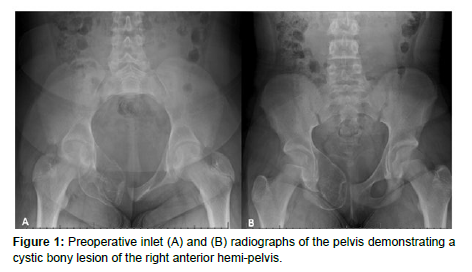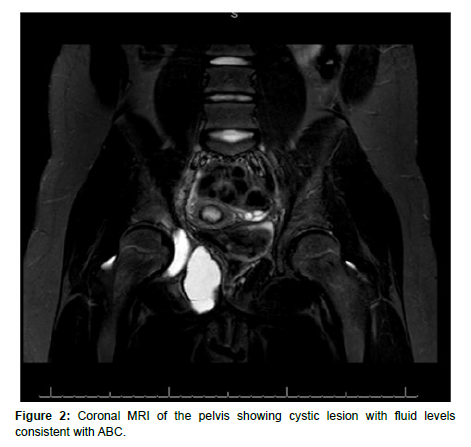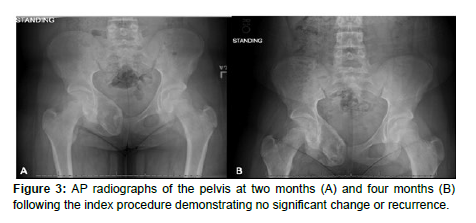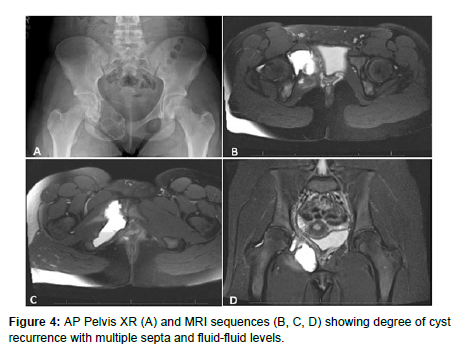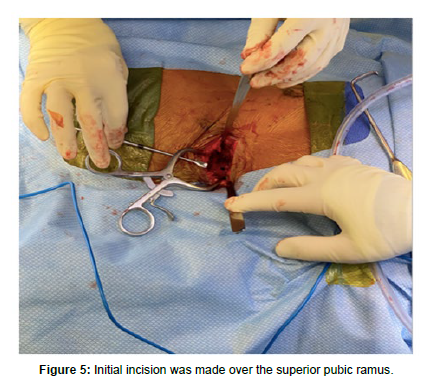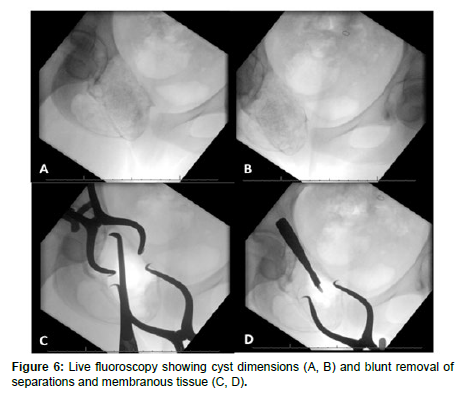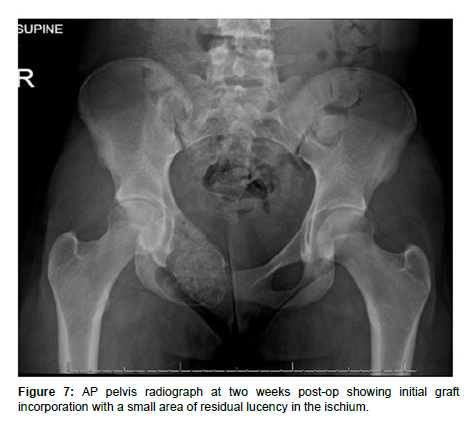Recurrent Pelvic Aneurysmal Bone Cyst Treated With Doxycycline: A Case Report
Received: 29-Dec-2022 / Manuscript No. joo-22-84176 / Editor assigned: 02-Jan-2023 / PreQC No. joo-22-84176 (PQ) / Reviewed: 09-Jan-2023 / QC No. joo-22-84176 / Revised: 24-Jan-2023 / Manuscript No. joo-22-84176 (R) / Accepted Date: 24-Jan-2023 / Published Date: 30-Jan-2023 QI No. / joo-22-84176
Abstract
Background: Aneurysmal bone cysts (ABCs) are locally aggressive, non-cancerous bone lesions that are rare, most commonly occur in children (75% of patients are < 20 yrs 1), and typically continue to spread until treated. They have a high risk of recurrence [1].
Methods: We present an 11-year-old female with a recurrent ABC of the pelvis, involving the right pubic ramus, ischium and medial wall of the acetabulum. She was treated initially with curettage and bone grafting but was discovered to have recurred at two-year follow-up. She was successfully treated with repeat curettage with iliac bone grafting and doxycycline as a sclerosing agent.
Results: At two and three-month follow up visits the patient continues to ambulate well, and radiographs demonstrate healing with successful graft incorporation and no sign of recurrence.
Conclusion: At the time of this publication, there were no reports detailing the use of doxycycline as a sclerosing agent for recurrent pelvic ABCs as extensive as the case presented here. However, doxycycline has been recently reported as efficacious in the treatment of other recurrent ABCs, primarily through percutaneous administration.
Introduction
Bone tumors can be classified according to the matrix or substance they produce [2]:
1. Bone-forming tumors (osteoid osteoma, osteoblastoma)
2. Cartilage forming tumors (osteochondroma, chondroma, chondroblastoma, chondromyxoid fibroma)
3. Fibrous lesions (fibrous dysplasia, ossifying fibroma, nonossifying fibroma)
4. Cystic and vascular lesions.
ABCs are classified as cystic and may be further classified as primary or secondary according to their etiology and account for approximately 1% of all primary benign bone tumors [3]. Although they can be found in any region, they are most commonly located within the posterior spinal elements, femur, and tibia [4]. It is estimated that 20-70% of treated ABCs recur in the first couple of years after treatment1. Until recently, ABCs were thought to result from a malfunctioning venous network within the bone, leading to dilation and rupture of local vasculature, but studies suggest that the underlying pathology may be due to arteriovenous fistulas developing within the bone [5]. The true cause is still uncertain [6]. Excision with curettage and bone grafting is considered the standard of treatment for these lesions [7]. Although various treatment options for recurrent ABCs have been suggested, doxycycline is emerging as a viable treatment option, and its use has been documented for lesions throughout the body [8].
Case Presentation
Our patient is an 11-year-old, African American female referred for functional groin pain for one year. History and physical exam were negative for constitutional symptoms, bowel or bladder symptoms, or vascular issues. She had no lower extremity motor or sensory deficits. Pain with full flexion of the right hip was noted. Plain radiographs of the pelvis (Figure 1) demonstrated an expansile lesion involving the right superior ramus, medial wall of the acetabulum, and ischium. MRI was obtained to further characterize the lesion, which showed a 7.0 x 5.4 x 5.3 cm expansile, intraosseous, multiloculated lesion with fluid-fluid levels involving the right superior pubic ramus and ischium consistent with an ABC (Figure 2). She subsequently underwent curettage with demineralized bone matrix and cancellous allograft.
Follow up
The patient did well postoperatively with improvement in symptoms. She could ambulate without pain and had full range of motion of the lower extremities bilaterally. No neurologic abnormalities were noted. Imaging of the pelvis revealed no change in the size of the mass over a six-month period (Figure 3). The patient was lost to follow up and returned 2 years later with complaints of recurrent right-sided hip pain for one year, exacerbated by daily activities such as walking and jumping. Physical exam demonstrated tenderness to palpation over the right superior ramus and pain with hip flexion. Imaging revealed the cystic area had increased in size compared to imaging studies two years prior with increasing lucency and multiple septa noted (Figure 4). The patient underwent repeat curettage with posterior iliac crest bone grafting augmented with cancellous allograft and doxycycline administration as a sclerosing agent.
Surgical Technique
A posterior iliac crest bone graft was first obtained with the patient in the prone position. She was then placed supine. Fluoroscopic visualization was used to determine the correct entry point over the involved superior ramus. A roughly 3 cm longitudinal incision was made over the ramus, medial to the femoral neurovascular bundle (Figure 5). The cyst was readily identified, and its thin wall allowed easy entrance with blunt instrumentation (Figure 6). A window, approximately 1x1 cm in dimension, was created using a Kerrison rongeur. The rangers were then used to break up the thin, deeper septa and remove membranous tissue. Curettage was performed, removing the remaining cyst wall tissue which was sent for pathology. Under fluoroscopic visualization, extensions of the cyst were probed with a curette to ensure all walls were accessible. The cyst was then irrigated with normal saline. 300 mg of doxycycline was diluted in 3 mL of normal saline and delivered along the cavity walls. The cyst was subsequently filled with morselized iliac crest bone graft and demineralized bone matrix (DBM). All parts of the cyst except the deepest portion of the ilium, which was difficult to access, appeared well-grafted.
Outcomes and Follow-up
At her two-week and three-month follow-up visits, the patient was convalescing well and ambulating without difficulty. On exam, the incision at the right pubis was well-healed without obvious infection. The posterior iliac crest incision site was also well-healed. Radiographs at each respective visit showed increasing graft incorporation and homogeneity. (Figure 7, Figure 8). The patient will have regular, 6-month visits to assess her long-term outcome.
Discussion
Aneurysmal bone cysts are slightly more common in females and often associated with USP6 gene rearrangement [9]. with a high recurrence rate (~ 25%), particularly in younger children. Until recently, ABCs were considered a non-neoplastic process of unknown etiology, and this was supported by several reports [10]. However, it is now reported that the chromosomal translocation t (16; 17) (q22; p13) is responsible for cytogenetic abnormality in ABCs, suggesting a neoplastic etiology in these lesions [11]. Multinucleated giant cells in ABCs are highly osteolytic due to high levels of matrix metalloproteinases (MMP-9 and MMP-10), tartarate-resistant acid phosphatase, and cathepsin K [12]. Osteolytic lesions of bone consequently increase levels of vascular endothelial growth factor (VEGF) in addition to MMPs [13].
Further, 30% of all ABCs are associated with other tumors, including giant cell tumors, chondroblastoma, fibrous dysplasia, and chondromyxoid fibroma [14]. The judicious use of denosumab or bisphosphonates has been shown to augment the efficacy of surgical management in cases of recurrence [15]. However, these antioncogenic drugs are not without their side effects. There is ongoing research to discover less toxic treatment options [16].
The tetracycline antibiotic, doxycycline has been safely used for over 50 years for many conditions including acne, rosacea, and a variety of bacterial and parasitic infections [17]. One of the wellknown side effects of doxycycline is that of suppressed bone growth in infants, children, and adolescents, and its routine, systemic use is contraindicated in these populations. This dose-related side effect is due to the calcium-binding effect of doxycycline which affects calcium orthophosphate metabolism. This is shown to occur after just one systemic dose, resulting in restricted bone growth [18]. Doxycycline has been well documented in its use as an anti-cancer agent [19]. It selectively reduces cellular respiration through restriction of mitochondrial protein translation, specifically the expression of four mitochondrial DNA encoded proteins (MT-ND3, MT-CO2, MTATP6, and MT-ATP8) by up to 35-fold [20]. This proves useful in targeting cancer cells which, due to their rapid, unregulated growth, require increased cellular respiration to survive [21]. This off-target effect poses doxycycline to be a potentially effective treatment option in the case of ABCs with modest systemic side effects, particularly with local administration rather than systemic dosing.
Doxycycline has demonstrated the healing of lymphatic malformations associated with elevated VEGF and MMPs [23]. In bone and soft tissue tumors, doxycycline demonstrates antitumoral properties thought to be due to the inhibition of MMP and factors involved in angiogenesis23. Additionally, Doxycycline has demonstrated inhibition of osteoclastic function, and induction of osteoclastic apoptosis [24]. One study demonstrated the effectiveness in percutaneous treatment of ABCs with doxycycline with 43% of patients experiencing resolution of symptoms after a single treatment [25].
Conclusion
Aneurysmal bone cysts (ABCs) are rare, highly destructive benign bone tumors, occurring in 1.4 to 3.2 people per 1,000,000 annually26. The morbidity of an ABC can be substantial depending on the location and size of the lesion. Due to the etiology of ABCs and their close association with other cancers, vascular and neurological conditions, caution should be taken when addressing these lesions and approached with a multidisciplinary team. Current treatment may be augmented with sclerosing agents such as anti-cancer drugs, which can have harmful side effects. These effects may be mitigated with the use of doxycycline, whose anti-cancer properties and more desirable toxicity profile are proving to be beneficial in this population. Continued follow-up with our patient will hopefully help add to the current literature supporting doxycycline’s use in treating recurrent ABCs.
References
- WHO Classification of Tumours Editorial Board, ed. (2020) 3 Bone tumours: simple bone cyst. Soft Tissue and Bone Tumours: WHO Classification of Tumours. Vol. 3 (5th ed.). Lyon (France): International Agency for Research on Cancer. pp. 437-439.
- Yildiz C, Erler K, Atesalp AS, Basbozkurt M (2003) benign bone tumors in children. Curr Opin Pediatr 15: 58-67.
- Hetaimish BM, Alshaya OS (2016) Pediatric aneurysmal bone cyst in the ischial region. Saudi Med J 37: 799-803.
- Dahlin DC, McLeod RA (1982) Aneurysmal bone cyst and other nonneoplastic conditions. Skeletal Radiol 8: 243-50.
- Stevens KJ, Stevens JA (2022) Aneurysmal Bone Cysts. In: StatPearls. Treasure Island (FL): StatPearls Pediatric Orthopedics in Practice. Springer pp. 151-155.
- Ibrahim T, Howard AW, Murnaghan ML, Hopyan S (2012) Percutaneous curettage and suction for pediatric extremity aneurysmal bone cysts: is it adequate? J Pediatr Orthop 32: 842-847.
- Mayerson JL (2013) percutaneous doxycycline treatment of aneurysmal bone cysts with low recurrence rate: a preliminary report. Clin Orthop Relat Res 471: 2675-2683.
- Andre M Oliveira, Bae-Li Hsi, Stanislawa Weremowicz, Andrew E Rosenberg, Nora Joseph, et al. (2004) Fletcher; USP6 (Tre2) Fusion Oncogenes in Aneurysmal Bone Cyst. Cancer Res 64: 1920-1923.
- Pfeifer FM, Bridge JA, Neff JR, Mouron BJ (1991) Cytogenetic findings in aneurysmal bone cysts. Genes Chromosomes Cancer 3: 416-419.
- Panoutsakopoulos G, Pandis N, Kyriazoglou I, Gustafson P, Mertens F, et al. (1999) Recurrent t(16;17)(q22;p13) in aneurysmal bone cysts. Genes Chromosomes Cancer 26: 265-266.
- Liu B, Yu SF, Li TJ (2003) Multinucleated giant cells in various forms of giant cell containing lesions of the jaws express features of osteoclasts. J Oral Pathol Med 6: 367-375.
- Kumta SM, Huang L, Cheng YY, Chow LT, Lee KM, et al. (2003) Expression of VEGF and MMP-9 in giant cell tumor of bone and other osteolytic lesions. Life Sci 73: 1427-1436.
- Howard YP, Sara KY (2022) Aneurysmal Bone Cyst-Pathology-Orthobullets. Curr Rev Musculoskelet Med 9: 435-444.
- Grahneis F, Klein A, Baur-Melnyk A, Knösel T, Birkenmaier C, et al. (2019) Aneurysmal bone cyst: A review of 65 patients. J Bone Oncol Aug 18: 100255.
- Yang EJ, Wu C, Liu Y, Lv J, Sup Shim J, et al. (2016) Revisiting Non-Cancer Drugs for Cancer Therapy. Curr Top Med Chem 16: 2144-2155.
- Akhyani M, Ehsani AH, Ghiasi M, Jafari AK (2008) Comparison of efficacy of azithromycin vs. doxycycline in the treatment of rosacea: a randomized open clinical trial. Int J Dermatol 47: 284-8.
- Cohlan SQ, Bevelander G, Tiamsic T (1963) Growth inhibition of prematures receiving tetracycline. Am J Dis Child 453-461.
- Ali I, Alfarouk KO, Reshkin SJ, Ibrahim ME (2017) Doxycycline as Potential Anti-cancer Agent. Anticancer Agents Med Chem 17: 1617-1623.
- De Francesco E, Bonuccelli G, Maggiolini M, Sotgia F, Lisanti M P, et al. (2017) Vitamin C and Doxycycline: A synthetic lethal combination therapy targeting metabolic flexibility in cancer stem cells (CSCs). Oncotarget 8: 67269-67286.
- Porcel JM, Salud A, Nabal M (2006) Rapid Pleurodesis with Doxycycline through a Small-Bore Catheter for the Treatment of Metastatic Malignant Effusions. Support Care Cancer 14: 475-478.
- Burrows PE, Mitri RK, Alomari A, Padua HM, Lord DJ, et al. (2008) percutaneous sclerotherapy of lymphatic malformations with doxycycline. Lymphat Res Biol 6: 209-216.
- Fife R, Rougraff B, Proctor C, Sledge G (2009) Inhibition of proliferation and induction of apoptosis by doxycycline in cultured human osteosarcoma cells. J Lab Clin Med 130: 530-534.
- Duivenvoorden WC, Hirte HW, Singh G (1997) Use of tetracycline as an inhibitor of matrix metalloproteinase activity secreted by human bone-metastasizing cancer cells. Invasion Metastasis 17: 312-322.
- Woon JTK, Hoon D, Graydon A, Flint M, Doyle AJ, et al. (2019) Aneurysmal bone cyst treated with percutaneous doxycycline: is a single treatment sufficient. Skeletal Radiol 48: 765-771.
- Boriani S, Lo SF, Puvanesarajah V, Fisher CG, Varga PP, et al. (2014) AOSpine Knowledge Forum Tumor. Aneurysmal bone cysts of the spine: treatment options and considerations. J Neurooncol 120: 171-178.
Indexed at, Google Scholar, Crossref
Indexed at, Google Scholar, Crossref
Indexed at, Google Scholar, Crossref
Indexed at, Google Scholar, Crossref
Indexed at, Google Scholar, Crossref
Indexed at, Google Scholar, Crossref
Indexed at, Google Scholar, Crossref
Indexed at, Google Scholar, Crossref
Indexed at, Google Scholar, Crossref
Indexed at, Google Scholar, Crossref
Indexed at, Google Scholar, Crossref
Indexed at, Google Scholar, Crossref
Indexed at, Google Scholar, Crossref
Indexed at, Google Scholar, Crossref
Indexed at, Google Scholar, Crossref
Indexed at, Google Scholar, Crossref
Indexed at, Google Scholar, Crossref
Indexed at, Google Scholar, Crossref
Indexed at, Google Scholar, Crossref
Indexed at, Google Scholar, Crossref
Citation: Summers TK, Austin Bettridge MSIV, Nimityongskul P (2023) Recurrent Pelvic Aneurysmal Bone Cyst Treated With Doxycycline: A Case Report. J Orthop Oncol 9: 188.
Copyright: © 2023 Summers TK, et al. This is an open-access article distributed under the terms of the Creative Commons Attribution License, which permits unrestricted use, distribution, and reproduction in any medium, provided the original author and source are credited.
Share This Article
Recommended Journals
Open Access Journals
Article Usage
- Total views: 7519
- [From(publication date): 0-2023 - Apr 26, 2025]
- Breakdown by view type
- HTML page views: 1694
- PDF downloads: 5825

